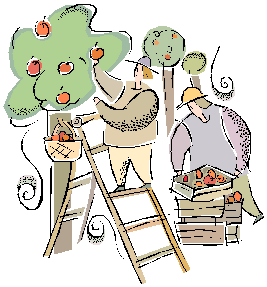

To send a message to an author, click on the author's name at the end of the article.
This Month in Ag Connection | Ag Connection - Other Issues Online
[Note: See below for tables of recommended planting rates and yield estimates by planting date.]
By analyzing planting and yield data collected in central Missouri over the last five years, specialists now have a better understanding of the relationship between planting date and seeding rate and yield response.
New recommendations point to early planting in late April and early May for 100 percent yield possibility – a departure from old recommendations for planting that began May 11 and ran at least 10 percent higher seeding rate than the new numbers.
Planting rate also comes into play when talking about yield. The collected data should help farmers decide how many seeds are enough.
For fields that typically yield more than 200 bushels per acre, agronomists recommend 36,000 plants per acre. While this rate might be optimal for fields in the Bootheel of Missouri and in fertile ground along rivers, specialists reduce that recommendation to 30,000 for more typical fields.
As seed prices continue to rise, this sort of data helps in decision-making.
| Yield Environment | ||
|---|---|---|
| Stand | Normal | High* |
| no. plants/acre | % of expected yield | |
| 36,000 | 100 | |
| 34,000 | 99 | |
| 32,000 | 98 | |
| 30,000 | 100 | 96 |
| 28,000 | 99 | 93 |
| 26,000 | 98 | 90 |
| 24,000 | 95 | 87 |
| 22,000 | 92 | 82 |
| 20,000 | 88 | 77 |
| 18,000 | 83 | 72 |
| 16,000 | 78 | 67 |
| 14,000 | 73 | 62 |
| 12,000 | 68 | 57 |
| *High-yield environments consistently produce yields of 200 bushels or more per acre. Soils are deep with excellent water-holding capacity. Irrigation is common. | ||
| Planting date | Yield estimates with new recommendation | Yield estimates from old recommendation |
|---|---|---|
| May 1 | 94% | |
| May 6 | 92% | |
| May 11 | 89% | 100% |
| May 16 | 86% | 99% |
| May 21 | 83% | 97% |
| May 26 | 80% | 94% |
| May 31 | 77% | 90% |
| June 5 | 75% | 85% |
| June 10 | 71% | 80% |
| June 15 | 65% | 75% |
Source: William Wiebold, MU Extension State Agronomy Specialist
This Month in Ag Connection | Ag Connection - Other Issues Online
Recessionary times have been a boom for the 'grow your own' gardening spirit. But growing fruit in Missouri (as compared to vegetables) can be challenging given our often erratic weather, disease pressure, insect pests and wildlife predation (e.g. birds), especially when ones mistake might not become apparent for 2 or more years.

Thus a common question by gardeners is 'which fruit crops are the easiest to grow and get a sure return on my money'? While answering this question is somewhat subjective, if one considers the relative ease of growing, popularity of the fruit, and time required before it begins bearing, five seem to rise to the top. And we have a recent publication that recommends cultivars known to perform well in Missouri. So as those gardening catalogs arrive in the mail through the winter, one might want to consider the below fruit crops, and their MU recommended cultivars.
Tree Fruit- Both apples and peaches will require annual pruning, fruit thinning and pesticide applications, the latter to control common disease and insect pests. However, many home gardeners practice minimal pesticide applications and report fairly consistent fruit production, given they tolerate fruit blemishes and are willing to use/consume the fruit more quickly than fruit commercially produced.
Apples- by selecting a disease resistant apple, less fungicide applications will be required. Recommended cultivars are Enterprise, Liberty, Goldrush, Redfree and Jonafree. Since smaller trees are usually preferred in a home garden, select a semidwarfing rootstock, or dwarfing if a 6 to 10 foot tree is desired. An additional advantage these growth resisting rootstocks have is the tree will begin to bear more quickly, within 3 to 5 years. Some gardeners get a limited amount of fruit set as quickly as 2 years. Wildlife is not normally a problem.
Peaches- Redhaven is a favored choice by home gardeners, being considered very hardy. Reliance, Contender, Cresthaven and Encore are also recommended. Unfortunately there is not a good dwarfing rootstock available for peaches. However, they begin bearing quickly, within 2 to 4 years. The 'fuzz' on peaches seems to benefit the fruit's resistance to some diseases, most notable being brown fruit rot which is the most devastating disease on stone fruit in Missouri. Thus peaches are considered easier to grow than nectarines. Wildlife is not normally a problem, although squirrels have been reported causing some fruit loss.
Brambles are among the easiest fruit plants to grow in Missouri. They generally do not require pesticide applications for disease or insect problems. Raspberries can be prone to root rot in poorly drained locations. While birds may cause some damage, the level or persistence is minimal compared to blueberries, cherries or grapes.
Blackberries are available with or without thorns, and both erect and semierect. Erect requires no trellis, but may benefit from some side support. Recommended thornless cultivars are Apache, Arapaho, Natchez, Navaho, and Ouachita; thorny cultivars are Chicksaw, Choctaw, Darrow, Kiowa and Shawnee. For semierect cultivars consider Chester, Hull and Triple Crown.
Raspberries- there are four types of raspberries, summer bearing red, fall-fruiting red, black, and purple.
Well adapted summer bearing red cultivars include Boyne, Canby and Latham. These cultivars typically bear only in June, beginning the year after planting.
Fall-fruiting cultivars performing well in Missouri include Heritage and Redwing. Given good growth after spring planting a small fall crop may occur.
Recommended black raspberries are Bristol, Blackhawk, and Jewell. The berry sizes of black raspberries are smaller than the other raspberries, but the flavor is unique.
For purple raspberries consider Brandywine or Royalty.
Strawberries will bear the year after planting, producing the fruit on the runners that grow off the planted crowns. Summer fruiting cultivars are more consistent performers because fruit ripening is concentrated in May to June, when (usually) more moderate temperatures favor better fruit quality. Weed control is the biggest pest issue, with a combination of hand weeding and mulching providing the best results for home gardeners. It is important to maintain beds at about one foot wide for disease control, and a further benefit if these are even minimally raised (e.g. 2 inches). Birds and mice or voles may be occasional pests, usually more of a nuisance than problematic.
Summer fruiting cultivars can be separated into early, midseason and late. Early maturing cultivars include Annapolis and Earlyglow, midseason are Delmarvel, Honeoye, Jewel, Mesabi, Redchief, and Surecrop, and late maturing are Allstar and Lateglow.
The everbearing cultivars such as Ozark Beauty, Ogallala, and Fort Laramie will produce a large May/June crop and a small fall crop.
Day neutral cultivars will produce a small May/June crop and after that, will continue to set fruit when summer temperatures are mild (they will not initiate flowers when temperatures are over 85 degrees F). Thus only in the fall will consistent fruit bearing resume. Tristar and Tribute are adapted cultivars.
All the most popular fruit crops prefer full sun. Site selection and proper spacing is critical for disease management. For more complete information on site selection, planting tips, fertilization, trellising, and pruning, see MG6 Fruit Production, which is the fruit chapter used for teaching the Master Gardener class. It is free and on the web at - http://extension.missouri.edu/explorepdf/mastergardener/mg0006.pdf.
Source: James Quinn, Horticulture Specialist
This Month in Ag Connection | Ag Connection - Other Issues Online
The amount of remaining phosphate rock reserves and resources worldwide has become an issue of speculation and concern to some. It has been hypothesized that phosphate rock production, the source of phosphorus (P) fertilizers, might "peak" in the years 2033-2034 and then production would unavoidably decrease as reserves are depleted.

Phosphorus is one of three major nutrients critical to plant growth so dire consequences for world agricultural production and food security are linked to "peak phosphate production".
A new report titled World Phosphate Rock Reserves and Resources released in September 2010 by IFDC (An International Center for Soil Fertility and Agricultural Development) estimates that there are sufficient global phosphate rock resources.
Reserves and resources of key rock phosphate producing countries were assessed using a variety of available information sources. The new study estimates global reserves at about 60 billion metric tons, which is about four times higher than the current, but outdated, estimates of the U.S. Geological Survey. The world will be able to produce phosphate rock concentrate, phosphoric acid, phosphate fertilizers, and other phosphate-based products for several hundred years.
The IFDC report (Technical Bulletin IFDC-T-75) is considered as Phase One of a comprehensive effort to thoroughly evaluate world phosphate rock reserves. Phase Two will be a collaborative effort among phosphate rock producers, government agencies, international agencies, organizations, and academia to further refine the world's reserves and resources.
International Plant Nutrient Institute (IPNI) scientific staff members have reviewed the new report and a summary of their comments appears at the IPNI website: www.ipni.net.
Further details of the study and information on obtaining copies of the 58-page report can be found at the IFDC website: www.ifdc.org.
Source: Jim Jarman, Agronomy Specialist
This Month in Ag Connection | Ag Connection - Other Issues Online
The warm heat from a wood stove can be very enjoyable on a cold winter day. But wood heating equipment needs careful attention to assure the safe and efficient use of this heat source. One area often ignored is the special care needed for the chimney.
Creosote accumulation is the main reason for cleaning a chimney. If the buildup of creosote on the chimney's inside surface ignites, a chimney fire results. Chimneys need cleaning to prevent this buildup and thus reduce the possibility of a chimney fire. The extremely high temperatures (up to 2,000 degrees F) of a chimney fire can damage the chimney. The heat can warp metal chimneys and crack the tile liner on masonry chimneys.
To avoid this tragedy, you need to establish a cleaning schedule that will free your chimney of creosote buildup. This schedule can range from once every couple of weeks to no less than once a year. How often you clean the chimney depends on the amount you use your stove, the type of wood you burn, the type of wood burning unit you have and the way you operate the unit.
You can either clean the chimney yourself or hire a professional chimney sweep. Chimney sweeps will do a thorough and professional job are available in many communities. Watching a sweep clean your chimney would not only be educational, but would also help you decide whether or not to tackle the job yourself next time.
Before deciding to clean your chimney yourself, consider your physical condition. Cleaning a chimney can be strenuous work. Pulling a chimney brush the height of the chimney can strain the back and other muscles. Make sure you are up to the job before starting.
The following are some of the more common methods for cleaning chimneys:
Wire chimney brush. The best method for cleaning your chimney is scraping it with a wire chimney brush. The brush may seem expensive, but for people who burn a lot of wood and must clean their chimney more than once a year, a brush gives the best results.
Other techniques. There are other techniques you can use with some degree of success, such as scraping the chimney with a burlap bag filled with straw or tire chains, chicken wire rolled into a ball, etc. The main disadvantages of these alternatives are that they are not able to provide enough abrasion to clean all the creosote out of the flue.
System management. Another cleaning technique that deserves careful consideration is system management. You can eliminate much of the creosote buildup with correct operation of the system. Burning well seasoned wood cuts down on creosote buildup.
Remember, chimney fires are very dangerous and are a major cause of wood burning related house fires. The more you do to keep your chimney in good working condition, the safer and more efficient your wood burning operation will be.
Further information on heating with wood can be found in the following publications at extension.missouri.edu or your local University of Missouri Extension Center:

G1730, Wood Stoves and Their Installation
G1731, Wood Stove Maintenance and Operation
G1732, Chimneys for Wood Stoves
G1733, Catalytic Combustors for Wood Burning Stoves and Furnaces
G1735, Cleaning Stovepipes and Chimneys
G5450, Wood Fuel for Heating
G5451, Preparing Wood for Your Wood Stove
G5453, Starting a Fire in a Wood Stove
Source: Kent Shannon, MU Extension Natural Resource Engineer Specialist
This Month in Ag Connection | Ag Connection - Other Issues Online
Publishing Information
Ag Connection is published monthly for Northeast and Central areas of Missouri producers and is supported by the University of Missouri Extension, the Missouri Agricultural Experiment Station, and the MU College of Agriculture, Food and Natural Resources. Managing Editor: Mary Sobba.